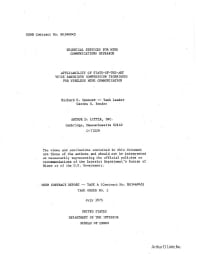Mining Publication: Technical Services for Mine Communications Research: Task A, Task Order No. 1 - Applicability of State-Of-The-Art Voice Bandwidth Compression Techniques for Wireless Mine Communication
Original creation date: July 1975
Authors: RH Spencer, WG Bender
NIOSHTIC2 Number: 10001368
Arthur D. Little,Inc. U.S. Department of the Interior, Bureau of Mines, Contract No. H0346045. NTIS No. PB 249-831, 1975 Jul; :1-88
The applicability of voice bandwidth compression techniques to mine wireless communication systems is examined. Promise has been attached to such techniques because the lessened bandwidth gave hope for lessened received noise and hence increased operating range or reduced transmitter power requirements. Analog vocoders and digital adaptive predictive coders are examples of real-time techniques. For these techniques, as the bandwidth gets narrower, the signal-to- noise ratio required rises, so that expected benefits of reduced transmitter power are not fully achieved. Benefits are achieved only through the use of sophisticated and costly equipment deemed impractical for most mine applications. However, non-real-time bandwidth compression achieved by stretching out the transmission time for a voice signal to several times its original duration can provide a savings in transmitter power but with an attendant time delay.

NIOSHTIC2 Number: 10001368
Arthur D. Little,Inc. U.S. Department of the Interior, Bureau of Mines, Contract No. H0346045. NTIS No. PB 249-831, 1975 Jul; :1-88
- Communication Systems Research At Bruceton Safety Research Mine
- Development of a Visual Display and Control System
- The Implementation of UHF Radio Communications and CCTV Monitoring Systems in a Room and Pillar Metal/Non-metal Mine
- Propagation of EM Signals in Underground Metal/Non-Metal Mines
- Propagation of EM Signals in Underground Mines
- Theory on the Propagation of UHF Radio Waves in Coal Mine Tunnels
- Through-The-Earth Wireless Real-Time Two-Way Voice Communications
- U.S. Bureau of Mines New Developments in Mine Communications
- Underground Mine Communications
- Wireless Through-The-Earth Modeling and Support